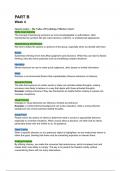PART B
Week 4
Guest Lecture - The Value of Psychology (Mischa Coster)
White Coat Authority
The concept of perceiving someone as more knowledgeable or authoritative, often
represented by symbols like lab coats (doctors), uniforms, or professional appearance.
Masses/Group Identification
We tend to follow the actions or opinions of the group, especially when we identify with them.
Biases
Systematic thinking errors that affect judgments and decisions. While they can lead to flawed
thinking, they also serve purposes such as simplifying complex decisions.
Heuristics
Mental shortcuts we use to make quick judgments, often based on limited information.
Noise
Random or environmental factors that unpredictably influence decisions or behavior.
Semantic Priming
The idea that exposure to certain words or ideas can activate related thoughts, making
someone more likely to behave in a way that aligns with those activated thoughts.
Example: Asking someone if they see themselves as helpful before making a request can
increase compliance.
Visual Priming
Changes in visual elements can influence mindset and behavior.
Example: a comfort-themed background can evoke relaxation, while a money-themed
background can evoke business-related thoughts.
Social Proof
People mimic the actions of others to determine what is correct or appropriate behavior,
especially in uncertain situations. When unsure about a decision, we often look to others,
particularly those who are similar to us, for guidance.
Gaze Cueing
When a specific direction or at a particular object is highlighted, we are instinctively drawn to
follow this gaze, thinking that there must be something important or relevant there.
Evoking Freedom
By offering choices, you make the consumer feel autonomous, which increases trust and
makes them more likely to comply. The key is to present the freedom subtly, without
overwhelming them with too many alternatives.
, Soft Persuasion
Status Quo Bias
We tend to prefer keeping things the way they are, perceiving change as a potential loss.
Zero Risk Bias
We prioritize minimizing risks, even if taking a larger risk could result in greater benefits.
Reactance Bias
When people feel their choices are being restricted or manipulated, they tend to resist or
push back.
Persuasion
Influencing someone’s attitudes, beliefs, or behaviors through communication or reasoning.
The goal is to get someone to adopt a particular point of view or take a specific action.
Catalyzing
Understanding why people are not already doing the desired behavior on their own. The aim
is to remove obstacles towards the desired behavior and to help people realize the benefits
of the behavior, allowing them to self-initiate the behavior change.
Reactance
Presenting options to give a sense of control, but limiting the choices to prevent
overwhelming.
Endowment Effect
Highlight the cost of inaction, showing what someone might lose by not taking an action.
Distance
Gain small commitments first (foot-in-the-door technique) to build up to larger commitments.
Uncertainty
Minimize perceived risk by offering free trials, easy returns, or guarantees (freemium).
Corroborating Evidence
Showing that similar people have taken the desired action (social proof). Multiple reference
points help to build credibility.




